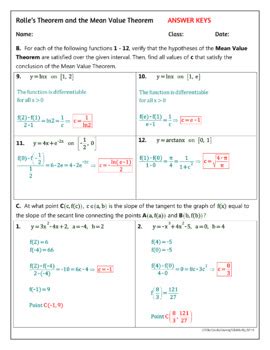Essential Concepts: The Mean Value Theorem
The Mean Value Theorem (MVT) is a cornerstone of differential calculus that establishes a crucial relationship between the average rate of change of a function over an interval and its instantaneous rate of change at a specific point. Formally, it states:

If f(x) is a function that is continuous on the closed interval [a, b] and differentiable on the open interval (a, b), then there exists at least one number c in (a, b) such that f'(c) = (f(b) – f(a))/(b – a). This number c is said to be a mean value of f(x) on the interval [a, b].
Practice Problems to Enhance Understanding
Problem 1:
Find all values of c in the interval [0, 2π] such that the tangent line to the function f(x) = sin x at the point (c, f(c)) is parallel to the secant line drawn between (0, f(0)) and (2π, f(2π)).
Problem 2:
Let f(x) = x^3 – 2x^2 + 1. Prove that there exists at least one number c in the interval (0, 2) such that f'(c) = 0.
Problem 3:
Consider the function g(x) = (x^2 + 1)^1/2. Show that on any interval [a, b], there exists at least one number d such that g'(d) = (g(b) – g(a))/(b – a).
Problem 4:
A projectile is launched vertically upward with an initial velocity of 100 m/s. Its height h(t) in meters at time t seconds is given by h(t) = 100t – 5t^2. Determine the time t at which the projectile’s instantaneous velocity is equal to its average velocity over the interval [0, 5].
Problem 5:
Let f(x) = 1/x. Use the MVT to prove that for any interval [1, a], where a > 1, there exists a number c such that f(c) = (a – 1)/a.
Applications of the Mean Value Theorem: Beyond Theory
The Mean Value Theorem plays a crucial role in numerous fields, including:
- Optimization: Determining extrema of functions
- Integration: Evaluating definite integrals
- Approximation: Estimating function values using linear approximation
Problem 6:
A company manufactures smartphones. The production cost per smartphone is modeled by the function f(x) = 0.005x^2 + 0.1x + 5, where x is the number of smartphones produced. Find the number of smartphones that the company should produce to minimize its average production cost over the interval [100, 500].
Problem 7:
The demand curve for a product is given by q = 1000 – 2p, where q is the quantity demanded and p is the price. Use the MVT to estimate the change in quantity demanded when the price increases from $50 to $60.
Problem 8:
A car is traveling along a straight road. Its velocity function is v(t) = 60 + 10t, where t is the time in hours. Approximate the distance traveled by the car over the interval [2, 6] using the MVT.
Customized Solutions to Real-World Challenges
The Mean Value Theorem empowers us to address real-world problems with precision. For instance:
- Manufacturing Optimization: Using Problem 6, manufacturers can optimize production to minimize costs, maximizing profitability.
- Market Forecasting: Solving Problem 7, businesses can better predict demand fluctuations and make informed decisions regarding pricing strategies.
- Transportation Planning: By leveraging Problem 8, city planners can estimate the distance traveled by vehicles and optimize traffic flow, improving commuting efficiency.
Conclusion
The Mean Value Theorem is an invaluable tool that enables us to understand and analyze functions. By engaging in practice problems, we deepen our comprehension of this fundamental concept. The applications of the MVT extend beyond theoretical settings, empowering us to solve real-world challenges in diverse fields such as optimization, approximation, and estimation.
